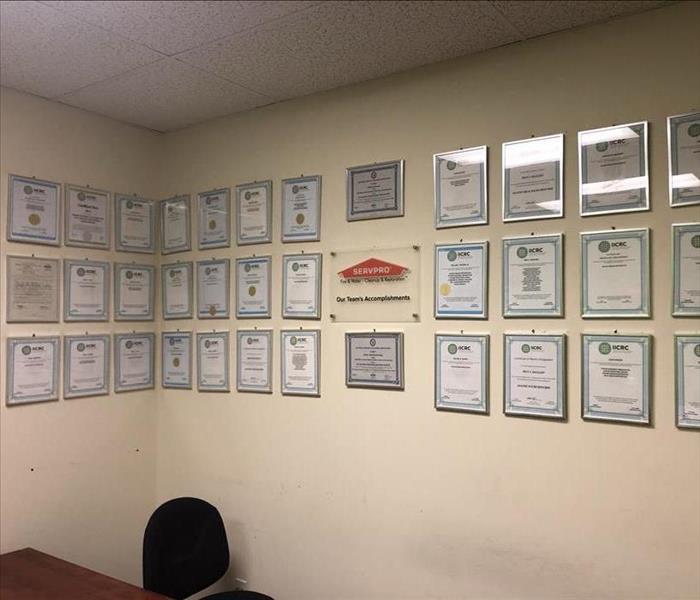How Can I Prevent Water Damage Caused By Plumbing Failures?
6/23/2020 (Permalink)
Certified Restoration Technicians Eliminate Water Damage From Durham Homes
Durham homeowners may be wondering what they can do to prepare for a plumbing-related disaster. A 1/8" pipe leak alone can bring dozens of gallons of water each day into your home. Without fast action, the moisture brought in by this kind of disaster can skyrocket home repair and replacement costs.
If your Durham home needs water damage mitigation services, SERVPRO technicians are available 24/7 to restore your property to a preloss state as efficiently as possible. Your local SERVPRO team is trained to prioritize repair over replacement when feasible to minimize your property loss. Restoration services extend to a variety of structural materials and belongings, including:
- Documents, electronics, and valuables
- Apparel and fabrics
- Upholstery and drapes
- Carpeting, floorboards, and subfloors
- Drywall, insulation, wall studs, and ceiling joists
What Causes Pipe Leak Water Damage?
There are several types of pipe leaks that can release varying amounts of water into your home. Here are the most frequent causes of residential pipe leaks:
- Loose fittings and connections. Every so often, pipe connections loosen and erode, and require occasional tightening or replacement.
- Unregulated water pressure. Water pressure that is too high can quickly erode pipes and create leaks.
- Pipes without insulation. In wintry weather, pipes that lack insulation can quickly become damaged by ice buildup inside. Ice expands inside the pipes, which can put enough strain on the plumbing to cause it to burst.
- Mechanical failures. Faulty installation or repair measures can lead to future water damage incidents.
SERVPRO technicians are trained in the mitigation of pipe leak water damage, no matter how small or large the disaster. Commercial-grade extraction, sanitation, and drying tools can prevent mold growth and structural damage to your property.
What Prevents Plumbing-Related Water Damage?
The key to preventing water damage from pipe leaks and plumbing failures in your home is reducing the stress on the system. Consider these tips for lessening the likelihood and frequency of plumbing failures in your home:
Soften Your Water
Lessen stress on your pipes by installing a water softener. The high amount of minerals in hard water can corrode the plumbing and create buildup inside water supply lines. Not sure if you have hard water? Check your locale’s most recent EPA water quality report. Water with minerals over 140 parts per million is considered to be hard.
The traditional solution for this is in the use of sodium-based softening agents. This process works by creating an exchange of ions between negatively-charged resin beads in the softener unit and positively-charged calcium and magnesium in the water. The sodium makes a brine that isolates minerals from the resin beads and washes them down the drain.
More recent developments allow for the use of electronic softening units, which can dissolve minerals with electromagnetic pulses.
Regulate Water Pressure
Monitor the water pressure in your pipes—normal levels for residential water pressure range from approximately 30 to 50 psi. Levels above 60 psi can cause problems for Durham residents, but this can be lowered with professional intervention or the installation of a pressure reducer. Residential water pressure should not exceed 80 psi.
Before adjusting your water pressure, check with neighbors to see if they have the same problem. If the problem is with the municipal water system, you may not even need to modify your water pressure.
Adjusting your own water pressure is a relatively simple process:
- Find the bell-shaped pressure regulator near your home’s water meter. Contact your utility provider if you are unsure where it is located on your property.
- Use a crescent wrench to loosen the lock nut somewhat. Turn the adjustment screw clockwise to increase water pressure and counterclockwise to decrease it. Adjust pressure one to two revolutions at a time.
- Test the pressure by letting a faucet run for a minute before making further adjustments.
What Does SERVPRO Use to Salvage My Home After Water Damage?
SERVPRO technicians tackle water damage in several steps. One of the most crucial is moisture measurement. Several tools are used to evaluate moisture levels in, on, and even behind surfaces, such as:
- Infrared cameras
- Penetrating and nonpenetrating sensors and meters
- Thermohygrometers
These measurements help technicians determine many crucial elements of the restoration process, including:
- Calculating drying goals for various surfaces
- Determining the placement of centrifugal air movers
- Placement and implementation of dehumidifiers based on the type of device, room size, and relative humidity, among other factors.
Without accurate calculations, the structural drying process can create secondary damages that can increase loss and slow down the mitigation process.
SERVPRO of North Durham strives to keep your home looking, “Like it never even happened.” You can call (919) 467-0880 for disaster mitigation service that can start within hours of your initial contact.

 24/7 Emergency Service
24/7 Emergency Service
